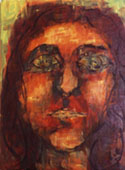

In 1996, Prince Charles had a Mask Campaign for purposes of charity, asking many artists and celebrities to paint plain clay masks as they wished; the book presenting these painted masks (simply called Masks), shows the way people used them, either to enhance or to hide, either their persona or their true character. Below is a description of some of the masks:
Some people were wide open, presenting their persona as conceived by the public; some appeared or close to their stage appearance; and some hid behind an enigma. Alec Guinness, for instance, painted on the mask the face of a clown, crying and laughing, and so did Meg Ryan in a simpler way; Kirk Douglas painted a one-eyed pirate, and Uri Geller a face combined of various mythological symbols; violinist Pinchas Zukerman filled his face with music notes, and Sir Anthony Hopkins—with fruit and flower decoration; Dame Diana Riggs' mask looks very mysterious, with a blank face full of golden bees, while David Bowie's blank face has Satan's number, 666, painted on its brow.
In conclusion, the mask, or disguise, is used to change and replace the identity of the wearer for various purposes. In ritualistic ceremonies, people dress up in order to present figures of power much greater than their own, for a better effect of the ritual. In the theatre, which is a descendent of the ritual, the mask used to replace the actor's everyday personality with his part in the play. Identical dress used as a uniform enhances the camaraderie and cooperation of the members of a group, while personal masks in a masquerade often reveal the wearer's hidden personality or aspiration. In art, a mask may be used to express the artist's ideas and feelings about certain issues. But a mask worn every day, as face painting, body tattoo or plastic surgery, presents to the world a person's persona, which may be quite different from his or her real or original identity. This multi-usage of the mask, the disguise and the dressing up, has been what makes them both useful and interesting from ancient times to this day.
 Tala Bar says, "I grew up in a library, my father was a librarian and my mother a bookbinder. My literary career started by translating into Hebrew a couple of classical books – Jurger by Cable and The White Goddess by Robert Graves. I translated more than twenty books of English classics.
Tala Bar says, "I grew up in a library, my father was a librarian and my mother a bookbinder. My literary career started by translating into Hebrew a couple of classical books – Jurger by Cable and The White Goddess by Robert Graves. I translated more than twenty books of English classics.
"Although I live in Israel, I acquired an M.Phil. degree in literature from London University. I have had published three novels, one book of stories and one book of poems – all in Hebrew. I now write literary articles on the Internet in Hebrew, and have my stories published in English."






















